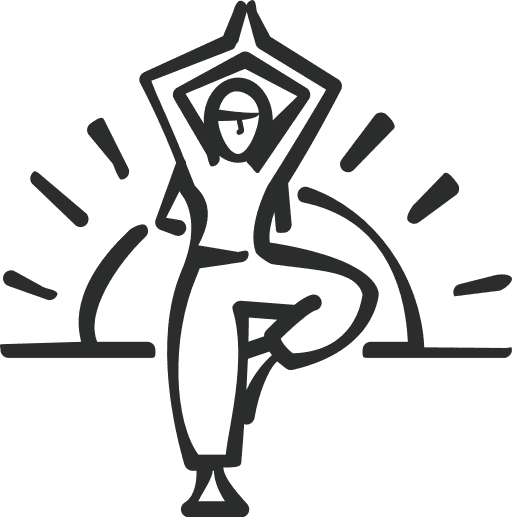
Trek the Everest Panorama Trail
Head high into the Everest region to hike among epic Himalayan scenery and explore Sherpa culture in the Sagarmartha National Park
What's Included?
Activities & Certified Guides
All itinerary activities with expert, local, English-speaking guidesAccommodation
2 nights in a hotel in Kathmandu, 1 night glamping and 6 nights in tea housesMeals
2 hotel breakfasts, plus welcome/farewell dinners in KathmanduInternal Flights & Transfers
Round-trip flights between Manthali and Lukla; all airport transfers, and everything in betweenPermits & Porter Service
Porters to carry your luggage on the trek, plus all your entry fees and permitsSmall Like-minded Groups
Solo-friendly by design, join our small n’ sociable groups of up to 12 like-minded, active and outdoorsy people…
…
What's it like?












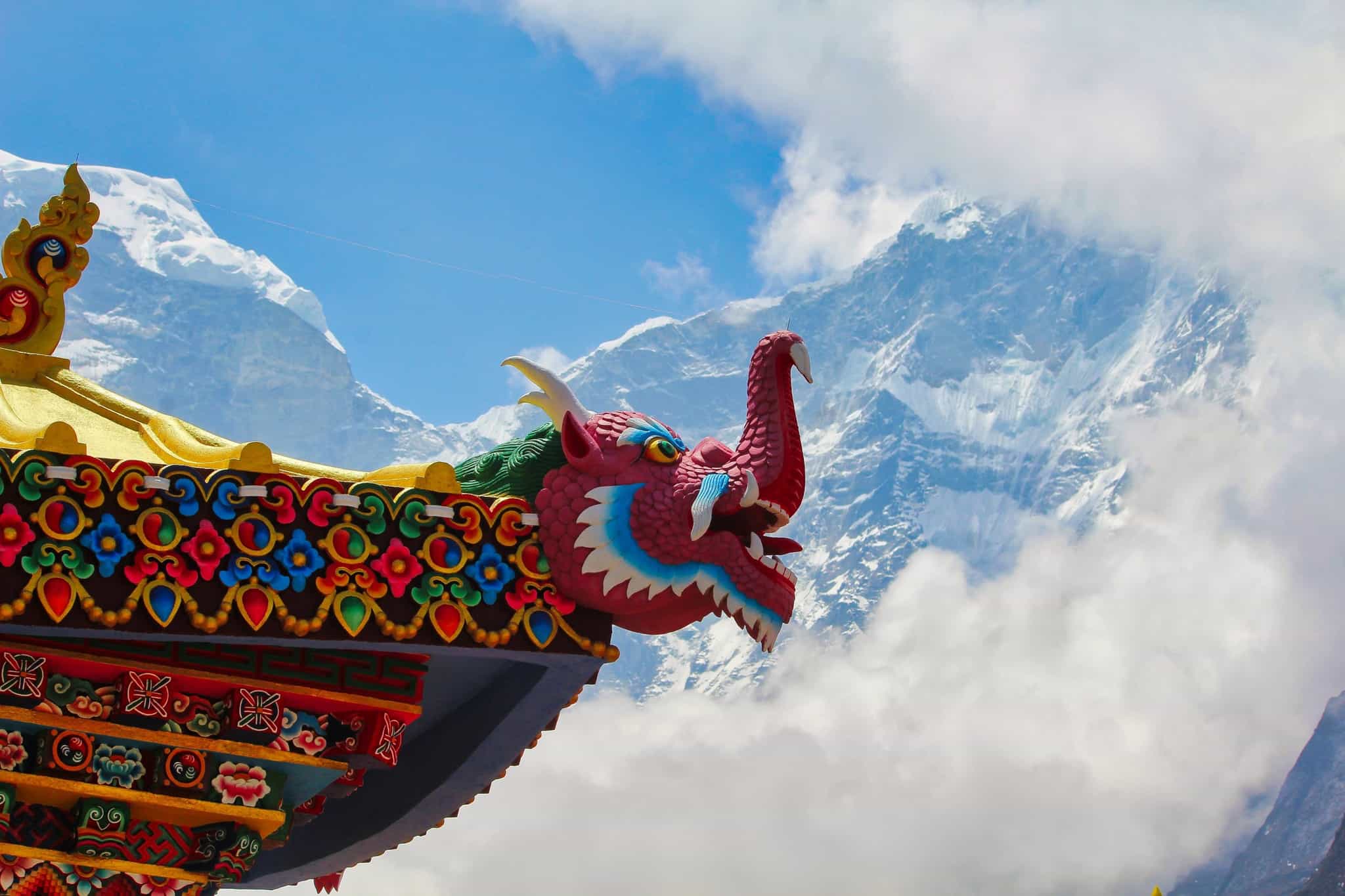
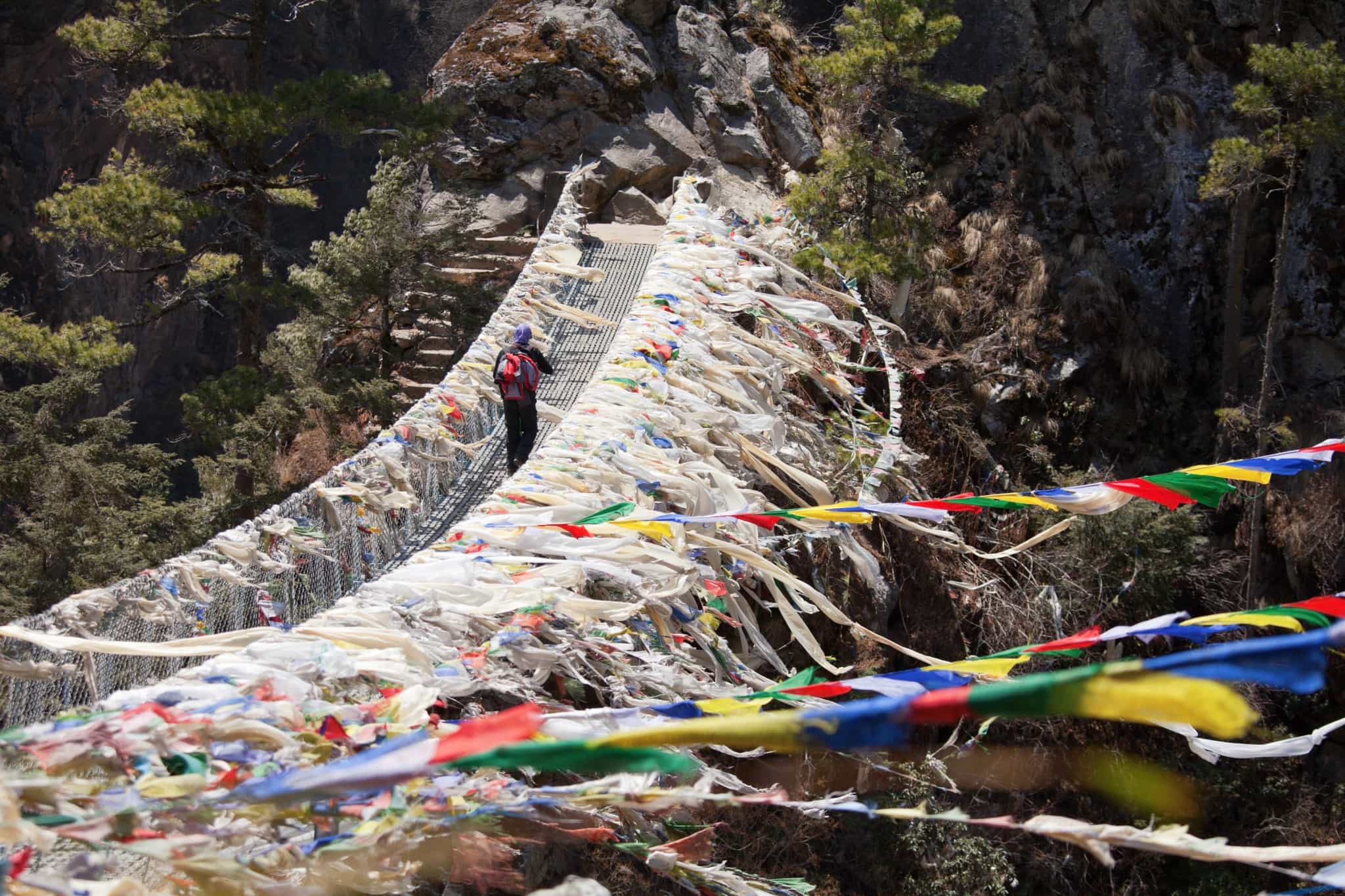
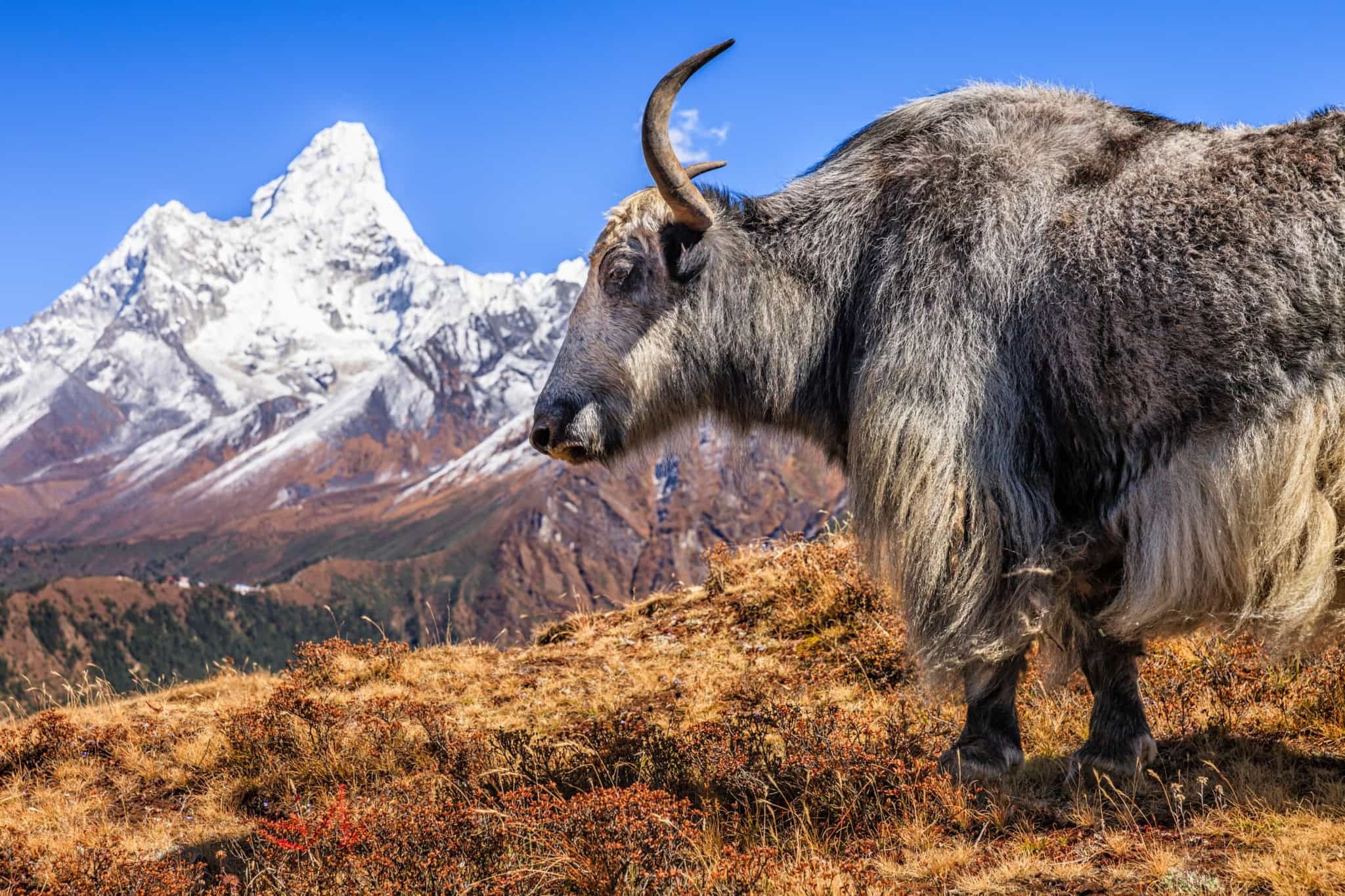

Trek through the Khumbu Valley to Namche Bazaar, the Sherpa capital, and on to Tengboche Monastery, one of the world's highest Buddhist gompas
Experience the highlights of the challenging Everest Base Camp trek at a relaxed pace, and without the extreme altitudes
Set your eyes on the highest point on Earth as you hike among views of Everest, Lhotse, Ama Dablam, Thamserku and many more snow-capped giants
Want to learn more? Read our handy guide or take on a bigger challenge with our full trek to Everest Base Camp
Key Information
Day 1
Welcome to Kathmandu!
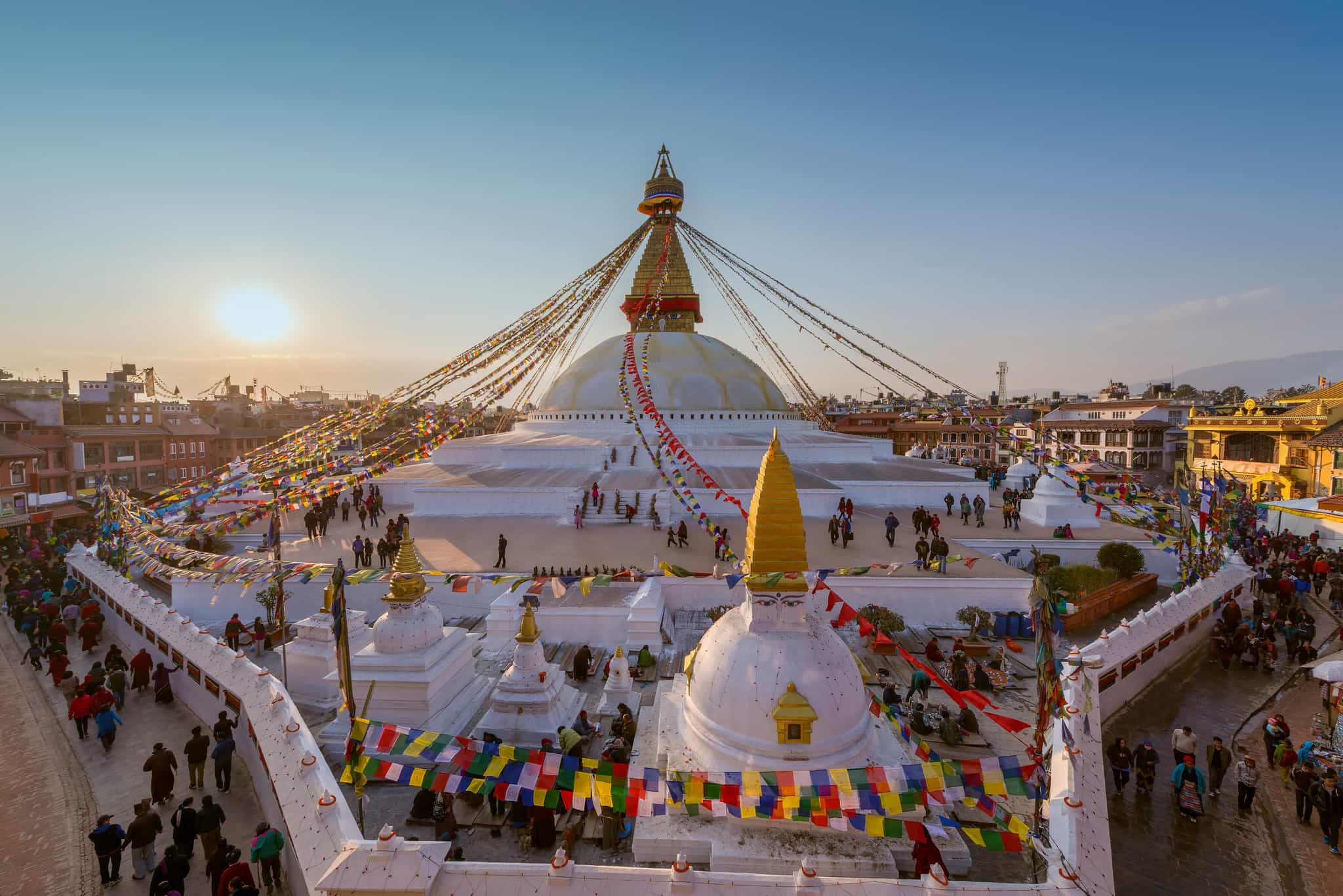
After checking in to your hotel, meet up with your guides and fellow travelers to go over the details of the adventure ahead. You'll finish the day with a group dinner at an authentic Nepali restaurant to get to know your team before the trek.
Day 2
Drive to Manthali
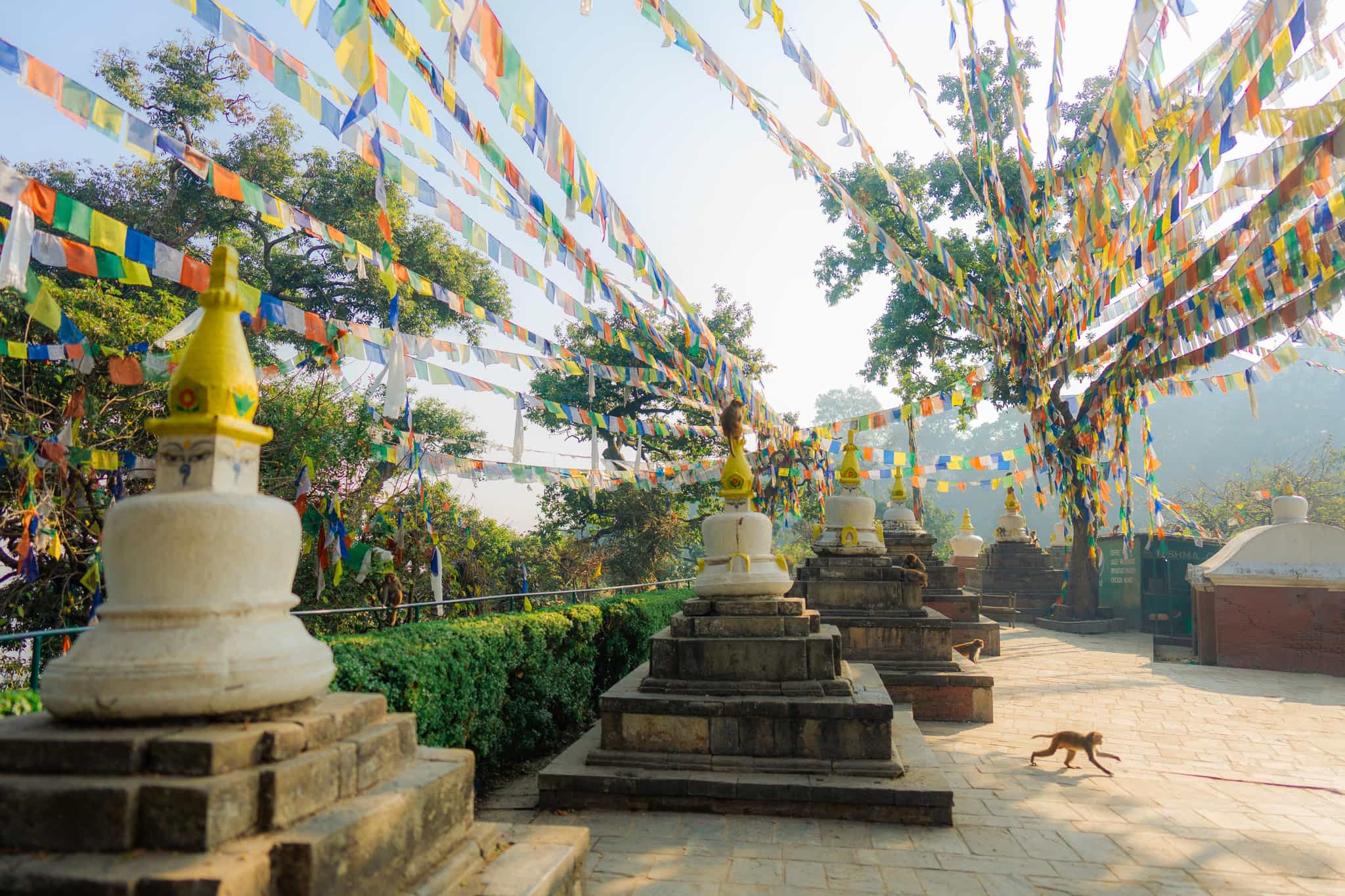
Driving
This morning, you'll hop on the bus and head to Ramechhap (Manthali) — the remote region where most Lukla flights now depart during peak trekking season.
After a long journey to Nepal, it’s crucial to rest and rehydrate before heading into the mountains. While many other itineraries rush you straight from your international flight into a midnight drive to Manthali, followed by a flight and same-day trek, we take a different approach. You’ll stay in safari tents at a glamping site near Ramechhap airport, giving your body a chance to reset before flying to Lukla and starting your trek tomorrow feeling fresh and ready. The resort has an on-site swimming pool, bar and restaurant so you can unwind after the drive.
(If your flight to Lukla is scheduled to depart from Kathmandu instead, you’ll enjoy an extra day in the city — time to explore at your own pace and pick up any last-minute gear.)
Day 3
Start your trek in the Khumbu
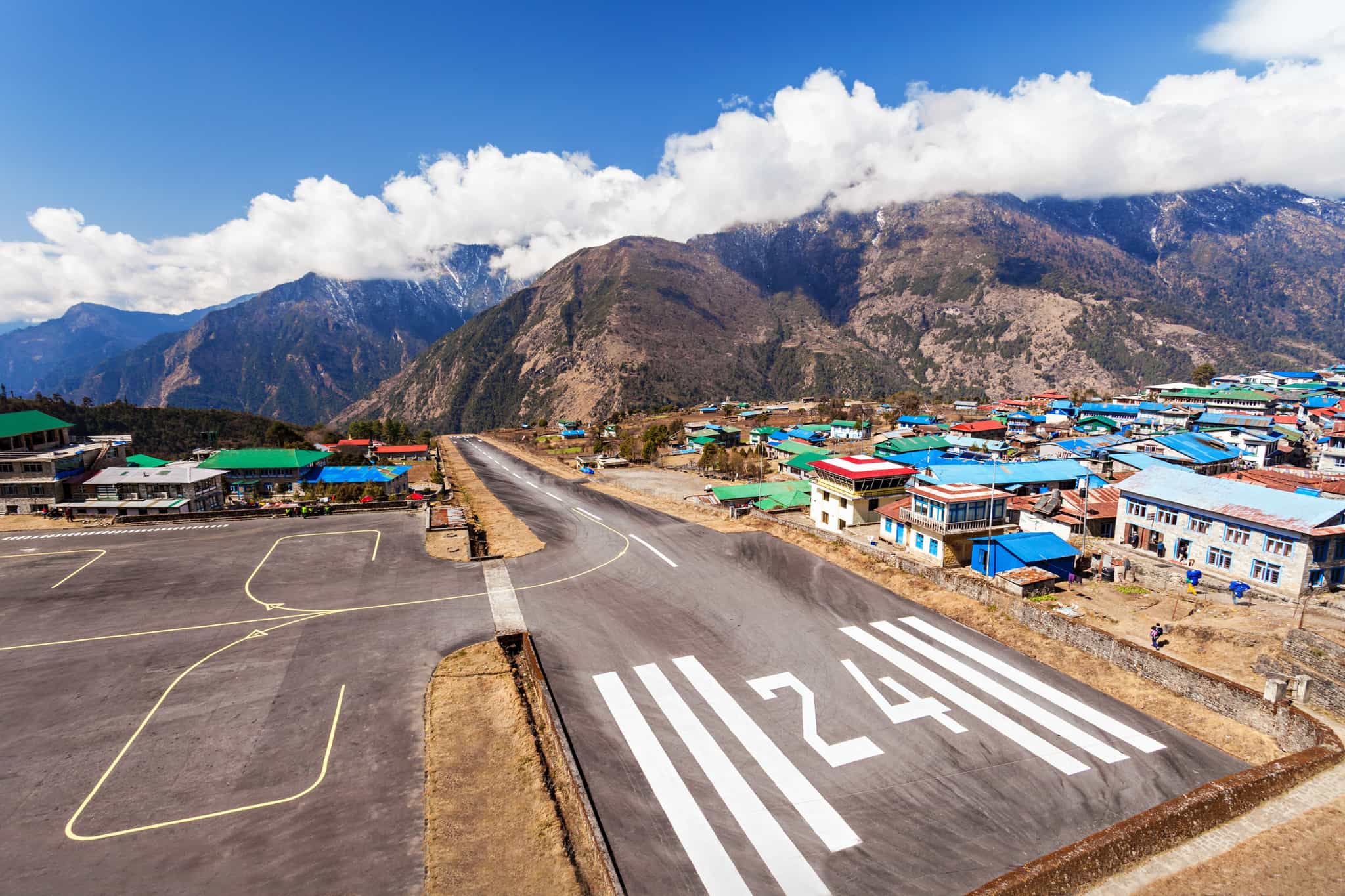
Hiking
Today begins with a short, 20-minute flight to Lukla, where you'll enjoy excellent views of the snow-capped peaks of the Himalayas. Perched high in the mountains, Lukla sits at 9,317 feet and is the gateway to Sagamartha National Park and Mount Everest. After meeting the other crew members, you'll start your trek, passing through the prosperous village of Lukla before reaching Phakding on the Dudh Kosi River. You'll spend the night in the village, where you can visit the nearby monastery for your first taste of Sherpa culture and Tibetan Buddhism, themes present throughout your trek over the days to come. Spend the evening in your cozy teahouse enjoying a herbal tea in front of the yak-dung fueled stove.
Please note that occasionally, Lukla flights can be delayed or canceled for safety reasons – see the FAQs for further info.
Day 4
Trek to the Sherpa capital of Namche Bazaar (11,290 ft)
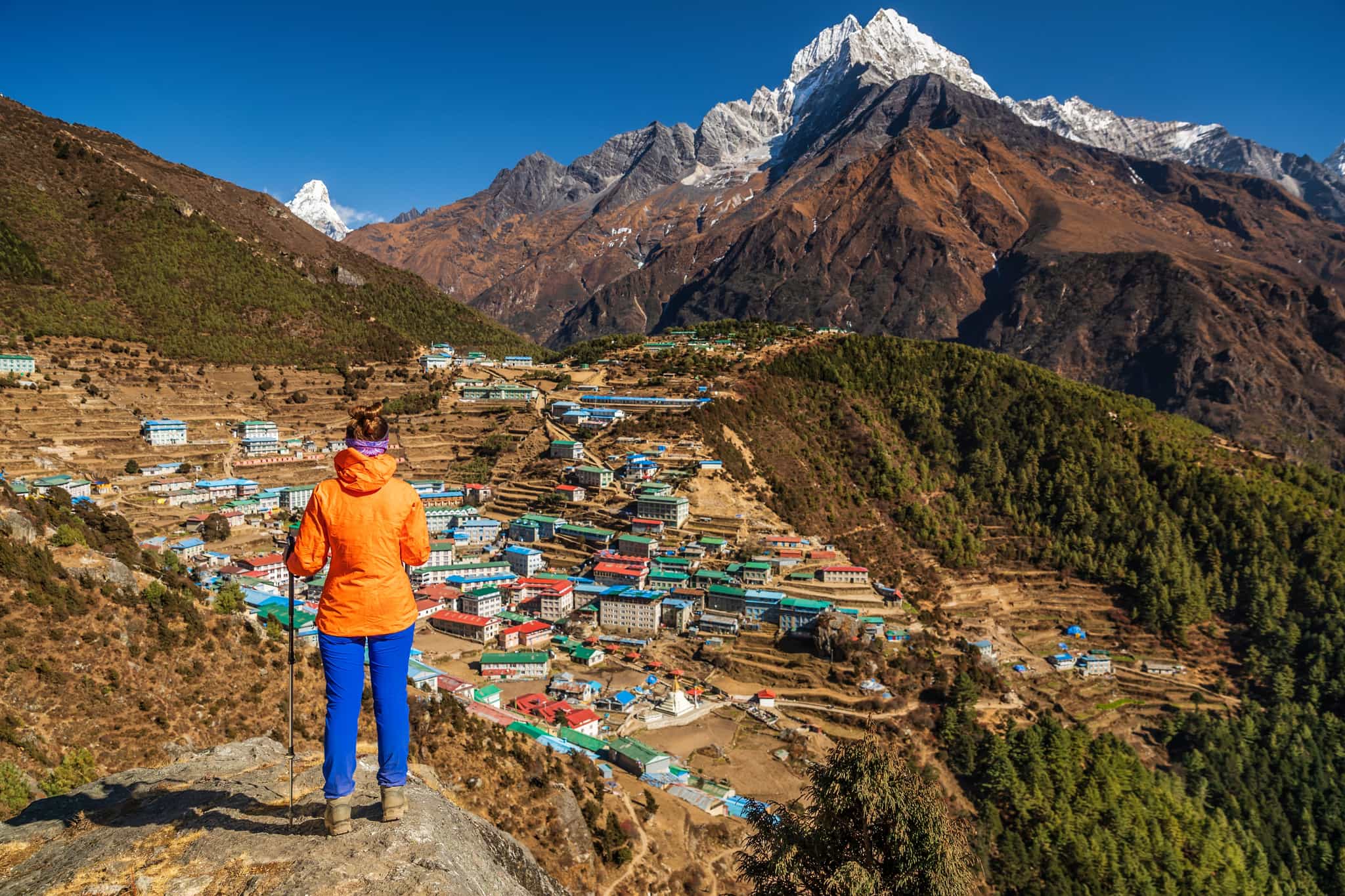
Hiking
Start today with a walk through beautiful pine forests, following the trail to the Dudh Koshi River. One of the (many) bridges you'll cross is the famous Hillary Suspension Bridge – named after the legendary mountaineer who was the first to summit Everest with Tenzing Norgay in 1953, it has a particularly epic viewpoint of the gleaming Mount Thamserku (21,712 ft). From here, continue through the village of Jorsale before a challenging uphill climb to Namche Bazaar, where you'll get your first glimpse of the mighty Everest.
Day 5
Acclimatize and explore Namche (11,286 ft)
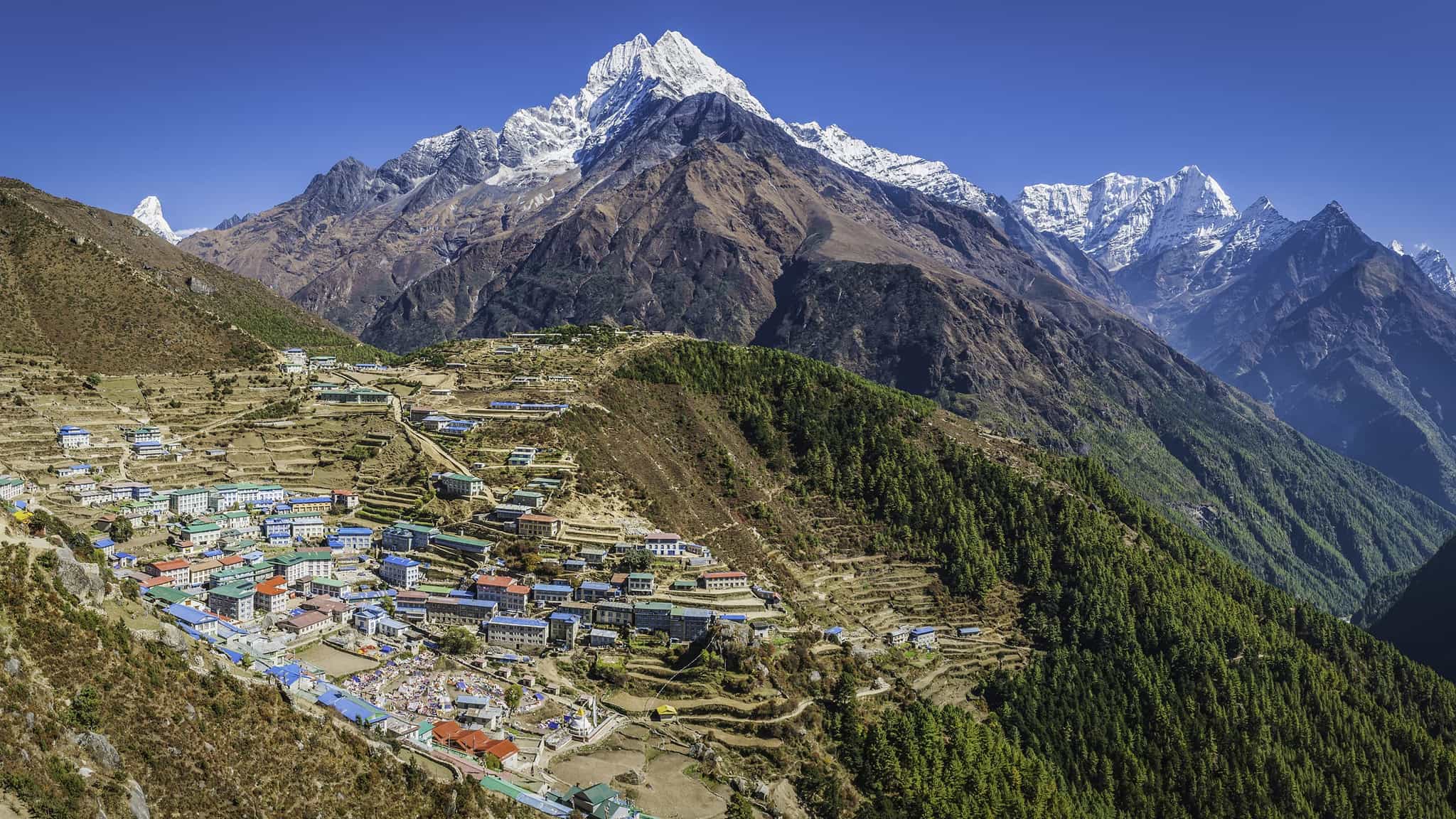
Today will be a rest day to acclimitize to the altitude – but rest assured, there'll be no time to get bored. Despite its remote location, Namche is a fun place to spend time – you can explore the bakeries, hiking and craft shops, watch old Everest movies at the cafe cinema, or even head to the highest Irish pub in the world. You'll also have the opportunity to hike to a nearby viewpoint and enjoy mammoth vistas of Mount Everest, Ama Dablam, Thamserku, Lhotse and more.
Day 6
Trek from Namche to Khumjung Village (12,434 ft)
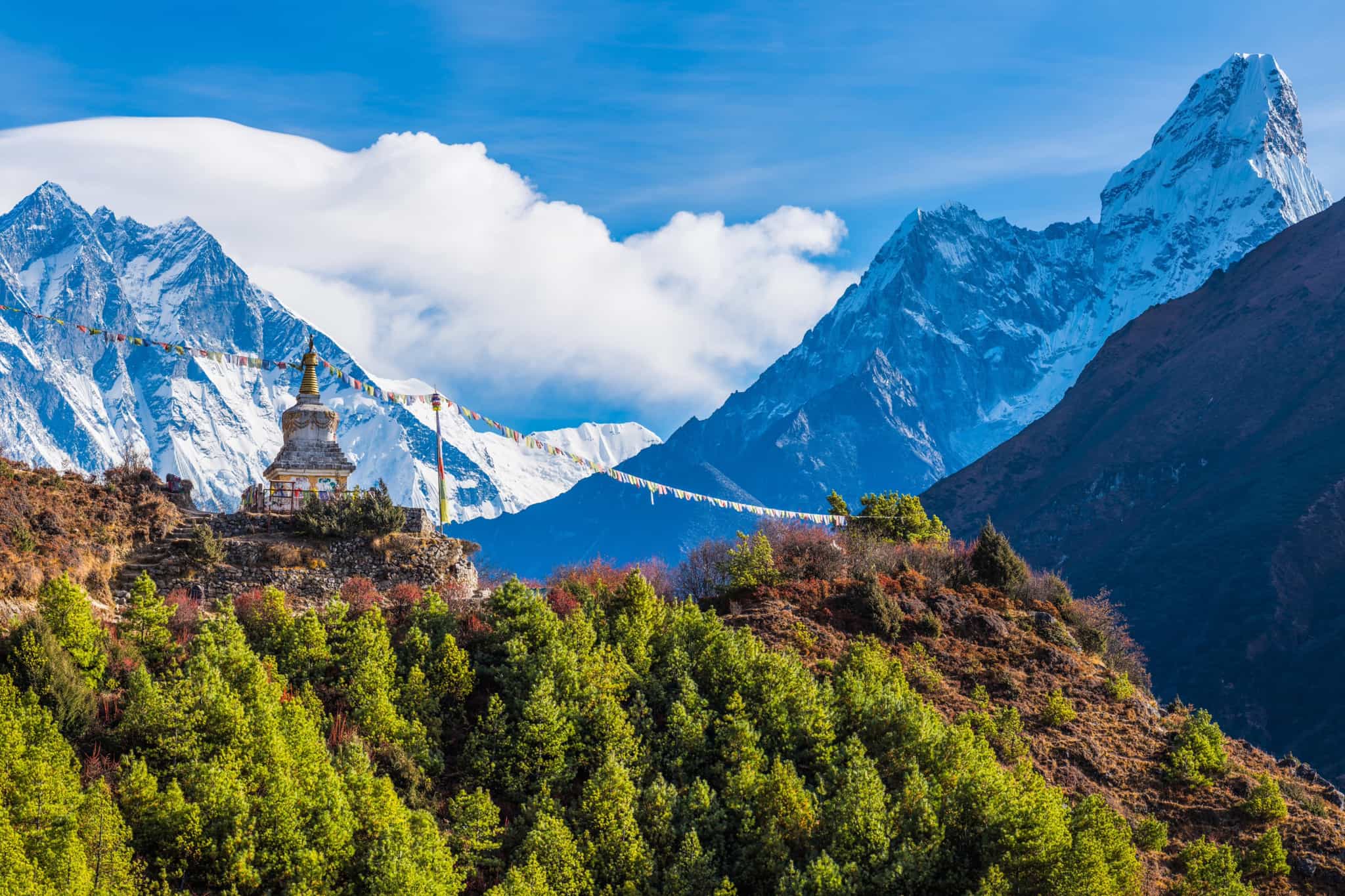
Hiking
Today, climb above Namche Bazaar to seek out one of the most stunning panoramic viewpoints in the Himalayas, where you'll be treated to breathtaking views of several of the world's highest mountains, among countless other snow-capped peaks. Stroll through the Khumjung Valley, taking in the remote mountain communities of Khunde and Khumjung. You'll pass the Khunde Hospital and Khumjung Hillary School, both built by Sir Edmund Hillary following his Everest ascent, and the intriguing Khumjung Monastery, which claims to house a relic of a 300-year old yeti scalp.
Day 7
Trek to Tengboche Monastery (12,664 ft)
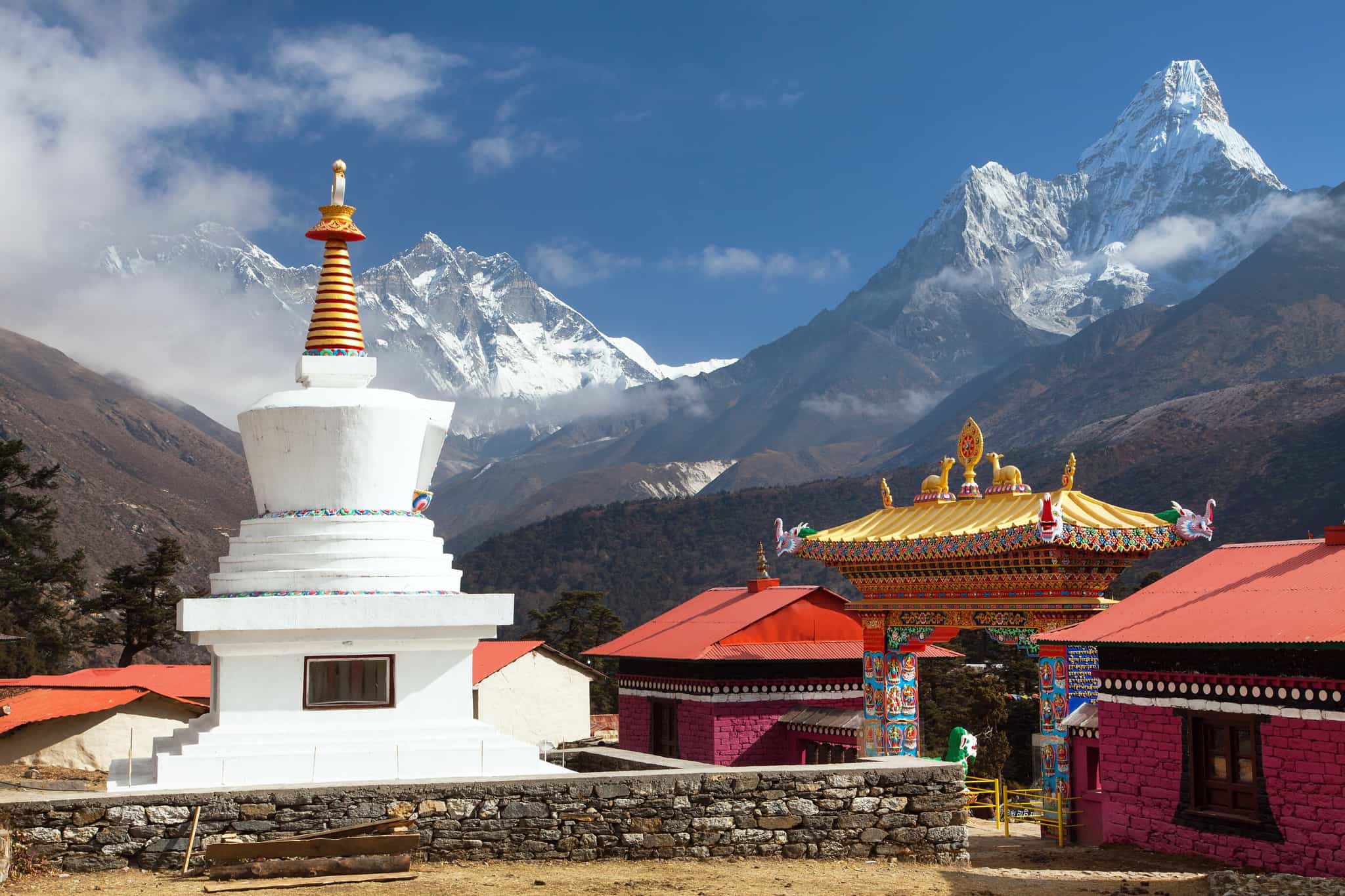
Hiking
Today the path forks, guiding you northeast into a tributary valley, revealing more stunning scenery as you climb the steep slopes toward the revered village of Tengboche. This hallowed ground, home to the famous Tengboche Monastery, also serves as a crucial grazing area for yaks and is the highest sacred site of its kind in the world. From here, drink in the breathtaking views of some of the Himalayas' most iconic peaks, including Nuptse, Lhotse, Ama Dablam – and, of course, the mighty Everest. A night’s stay in Tengboche rounds off a remarkable day.
Day 8
Head back down to Namche (11,290 ft)
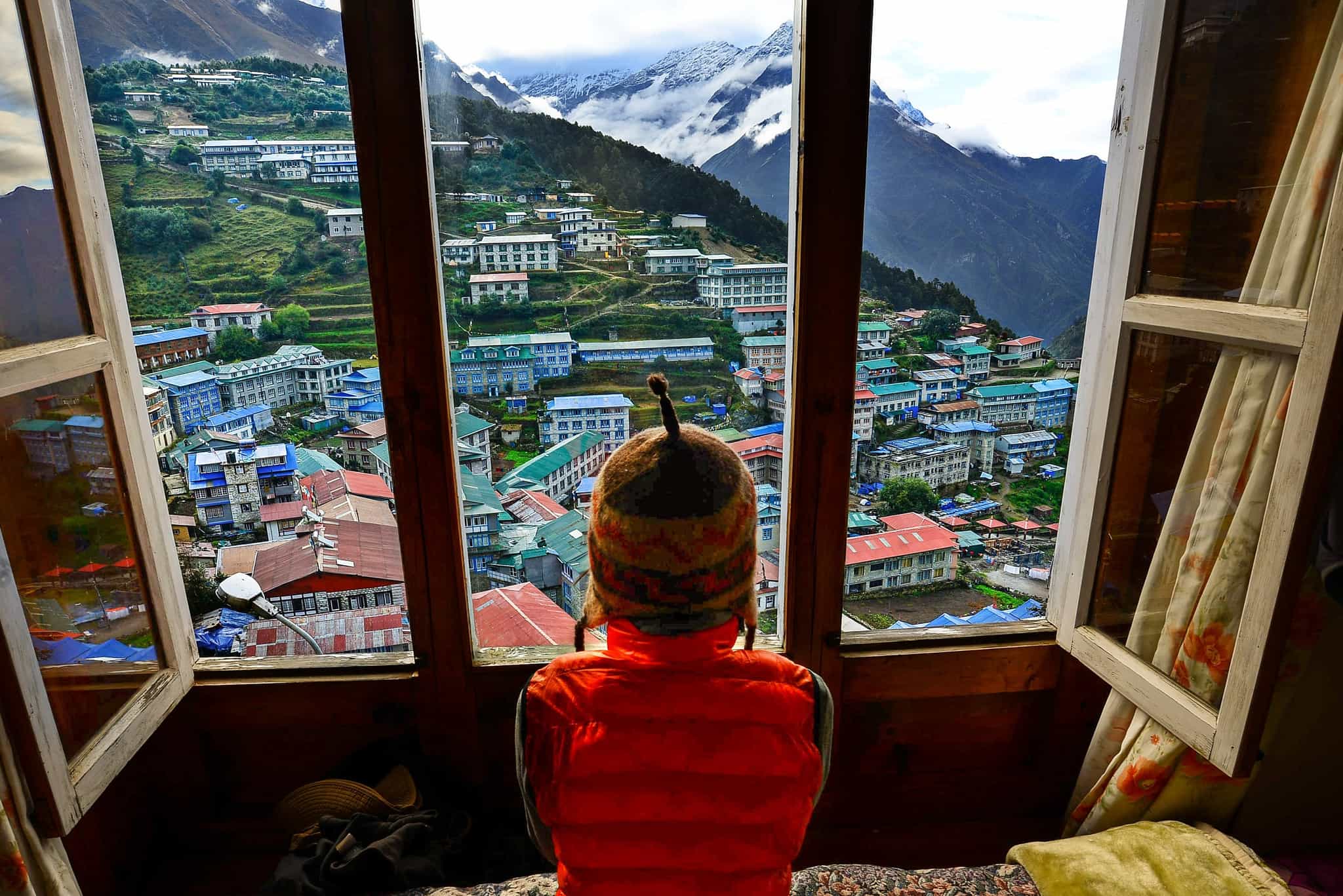
Hiking
After your night in the spiritual setting of Tengboche, it's time to start your descent back down the valley. You'll pass the village of Phunke Teng, crossing a large suspension bridge on your way, and have the chance to soak up more incredible views of the ever-present Himalayan peaks high above you. The going is much easier on the way down, now that you are acclimatized to the altitude, so you'll have more energy to capture those perfect photos and enjoy the journey. Continuing for a couple of hours, you'll return to Namche Bazaar where you'll have the afternoon to explore the town and enjoy a last evening in the Sherpa capital.
Day 9
Namche to Lukla (9,317 ft)
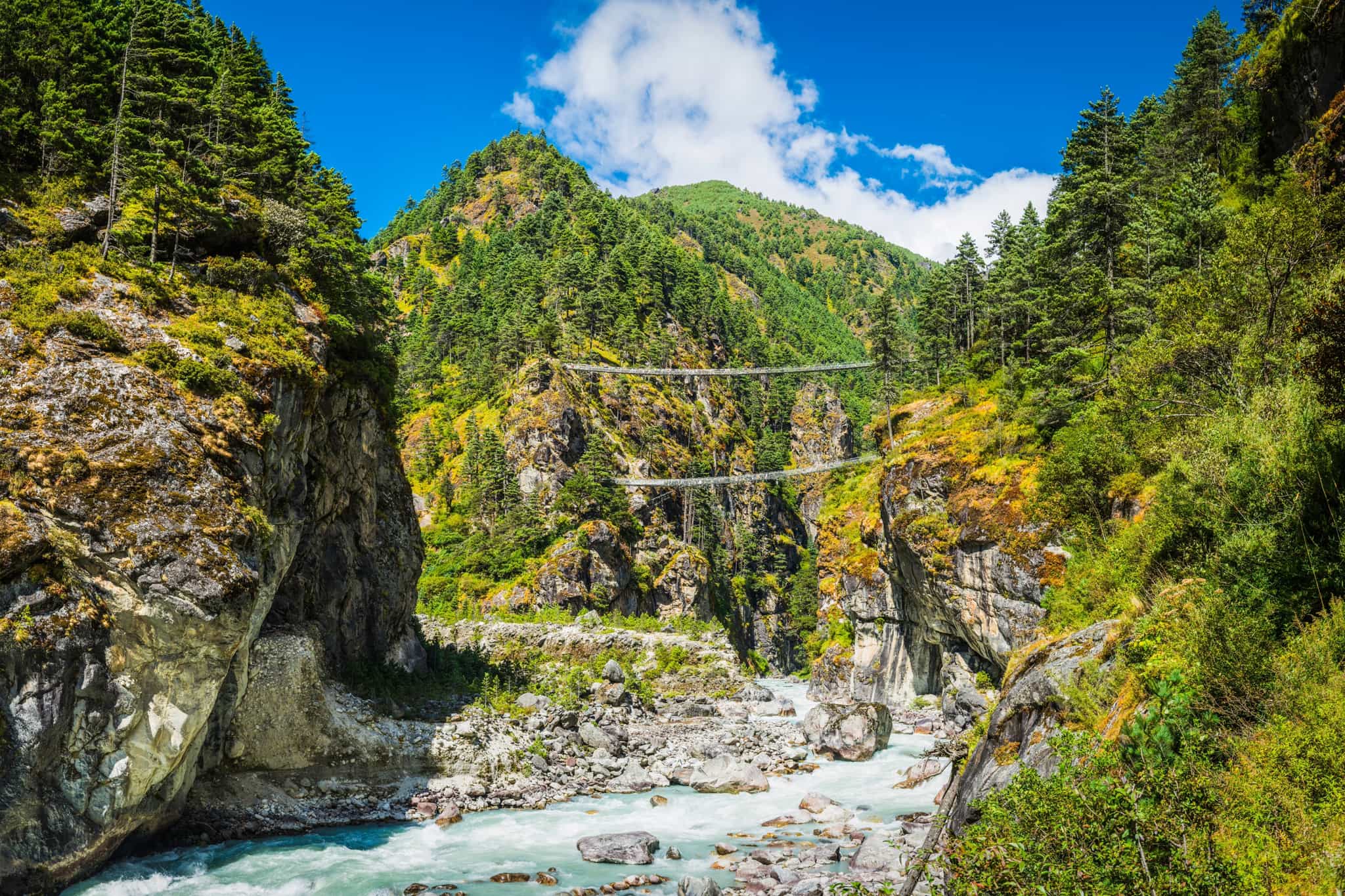
Hiking
Set off for the final descent into Lukla (9,383 ft). On the way, you'll trek through a forest of rhododendrons and pine until you reach a Sherpa village. Here, you’ll have the opportunity to say your final goodbyes to the local team before moving on to Lukla.
Day 10
Back to Kathmandu
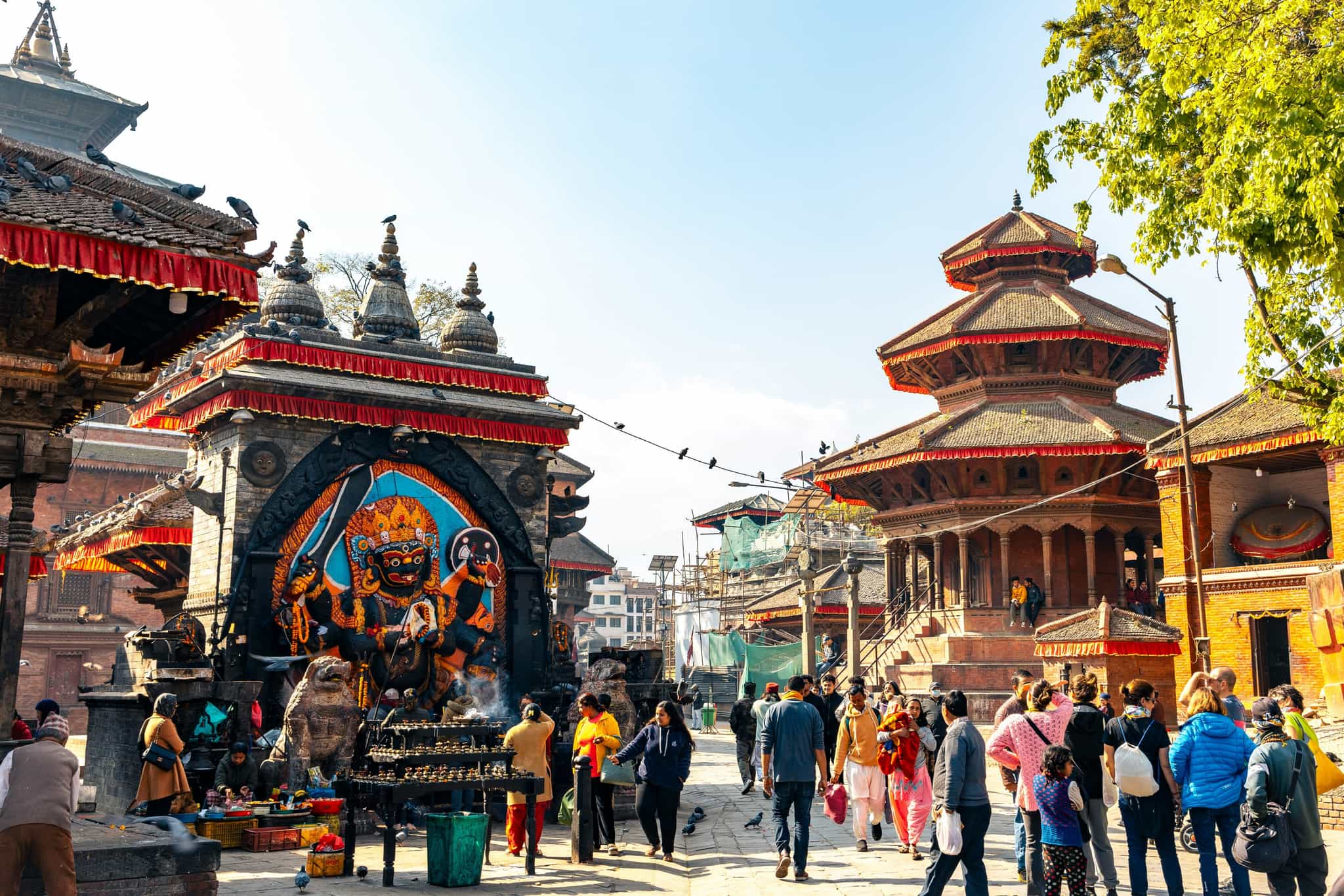
Driving
Fly back to Manthali after your incredible mountain journey. You'll drive back to Kathmandu in time for some well-earned beers and a celebratory dinner.
Day 11
Time to head home
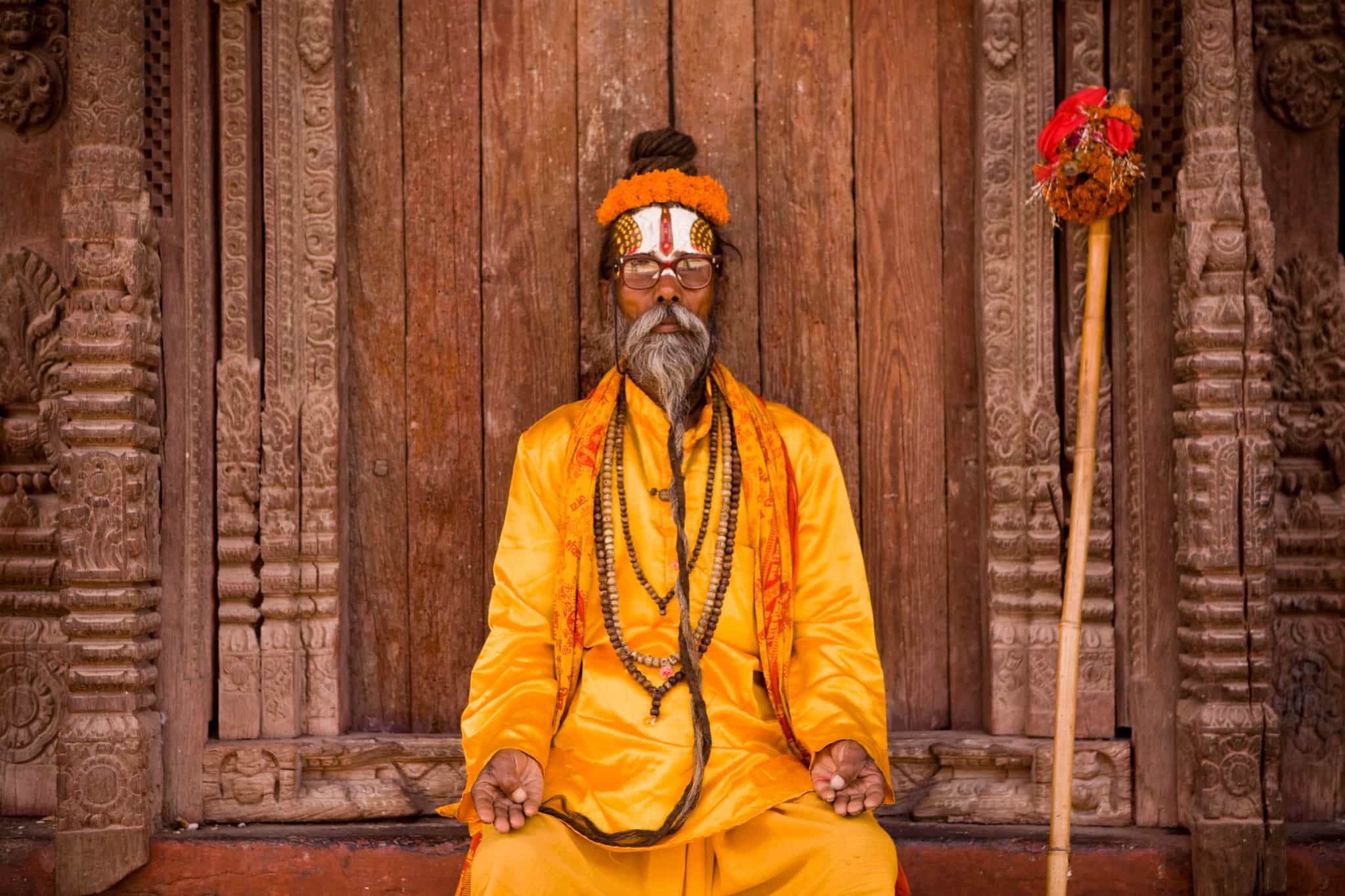
Enjoy a well-earned sleep-in and breakfast at your hotel, then spend your last day exploring the city before heading back to the airport, and reality.
The Area
Logistics
Starts
Kathmandu Airport (KTM)
Any time on Day 1
Ends
Kathmandu Airport (KTM)
Any time on Day 11
Transfers
Airport arrival and departure transfers are included in the trip cost, no matter when you arrive and depart (even if booking extra nights before or after the trip), provided you have completed your passenger info form and have supplied your flight details in advance.
Travel options
There are regular flights to Kathmandu from major airports in the UK and Europe.
Day 1
Breakfast
Lunch
Dinner
Day 2
Breakfast
Lunch
Dinner
Day 3 – Day 4
Breakfast
Lunch
Dinner
Day 5
Breakfast
Lunch
Dinner
Day 6 – Day 9
Breakfast
Lunch
Dinner
Day 10
Breakfast
Lunch
Dinner
Day 11
Breakfast
Lunch
Dinner
What is the food like?
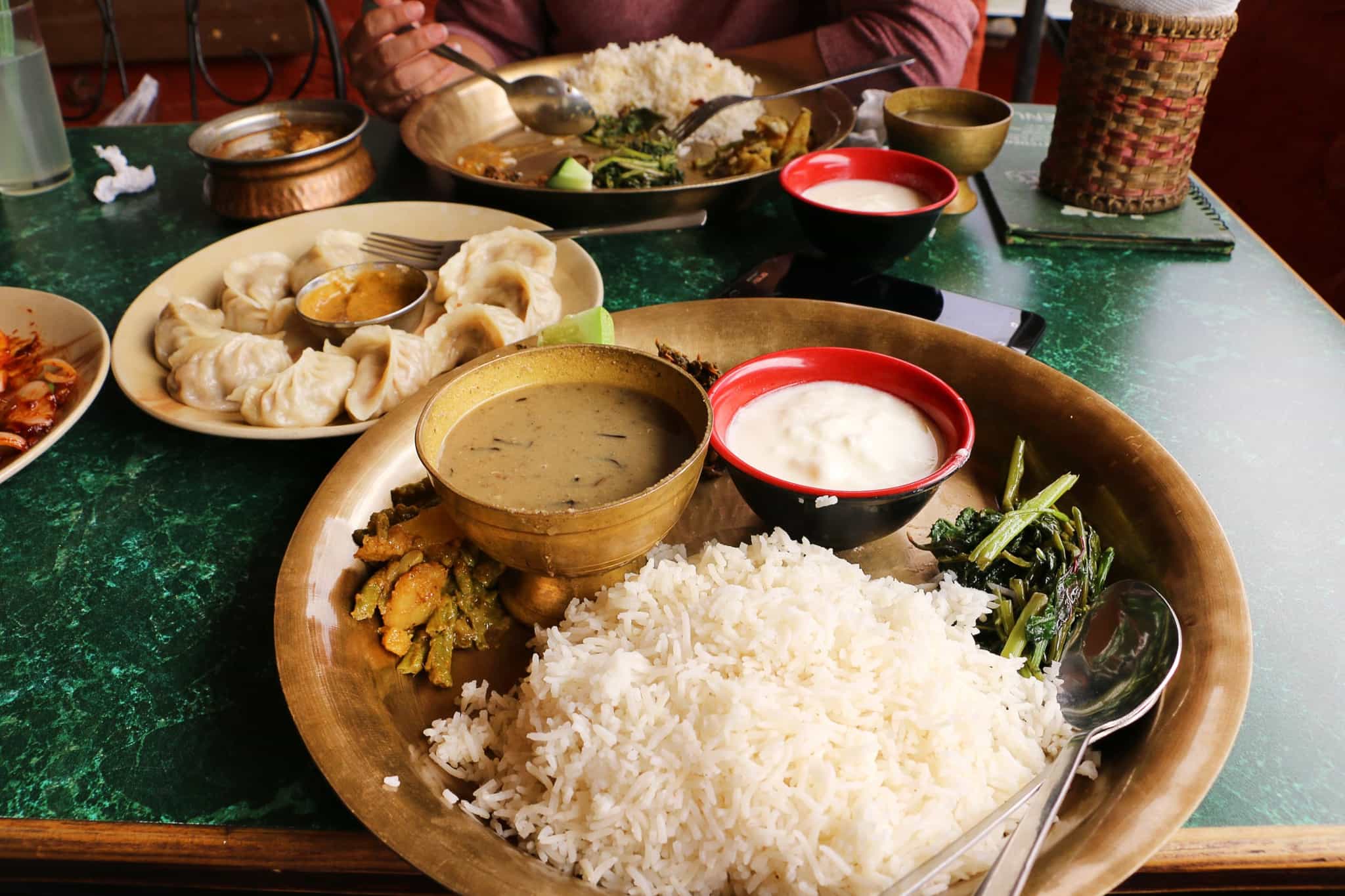
Breakfast is usually hot oatmeal, muesli or Tibetan bread served with an omelet or boiled eggs. The menus in the teahouses are very similar at every stop and there will usually be a choice of traditional Nepalese dhal bhat (a mixed plate of lentils, rice, vegetables and pickles - delicious and healthy), Nepalese dumplings (momos), mixed noodles, pasta and even pizza. Although meat is available at some teahouses, we suggest you ask your guide for advice about consumption as it tends to depend on how far it has traveled as to whether it is a safe option.
Dairy-free, vegan or vegetarian diets can be catered for while trekking although meals may get a bit repetitive – dhal bhat will likely be your go-to staple. Gluten-free/celiac diets are tricky to cater for on teahouse treks (beware that powdered soups and seasonings used often contain gluten, and cooking oil is commonly reused and may cause cross-contamination). Please explain your dietary requirements to your guide so that they can assist when ordering, and bringing along some extra food/snacks is advisable.
What is the accommodation like?

Kathmandu
You’ll stay in a centrally located hotel in the heart of Kathmandu's Thamel district, close to the main shopping area and heritage sites. You'll stay in a twin-share en suite room, with air-conditioning and WiFi included.
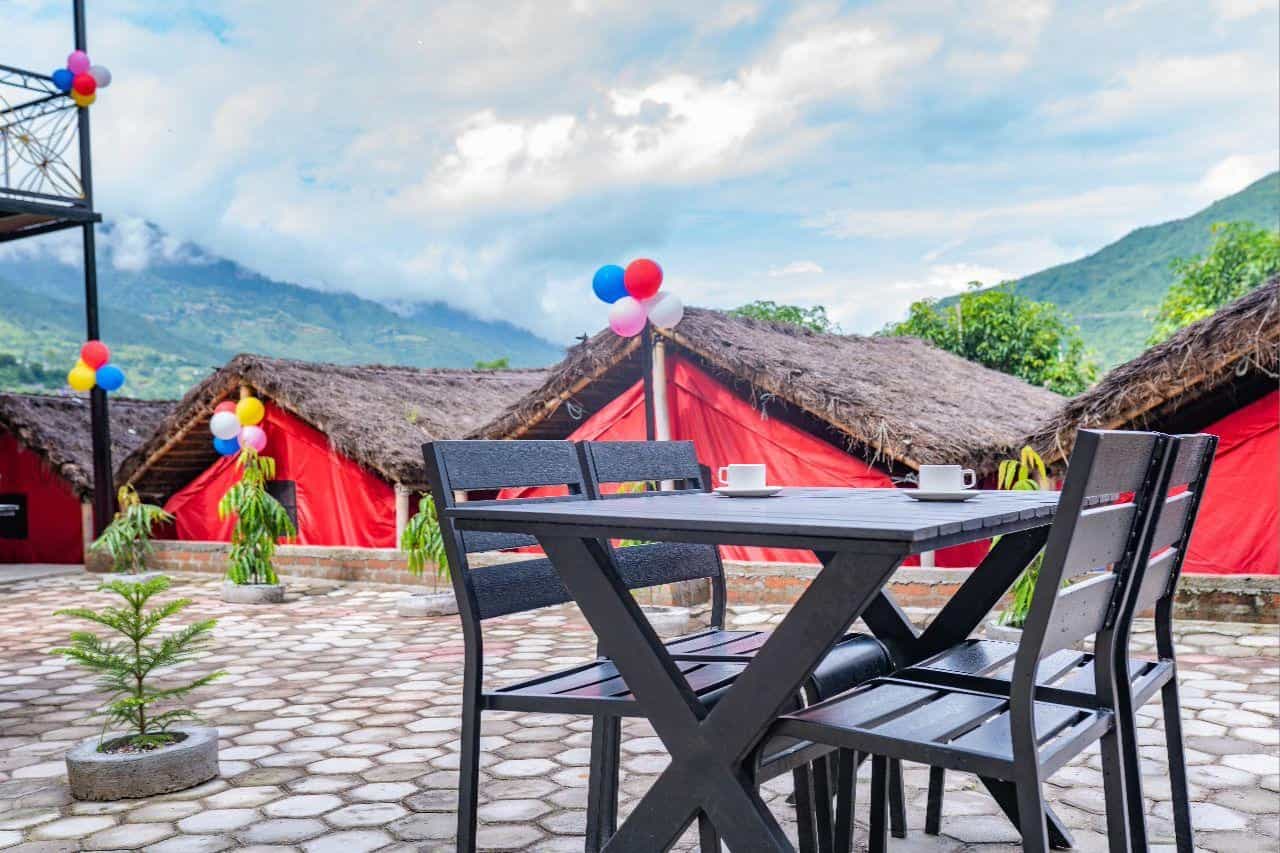
Manthali
For your night in Manthali, you will stay in safari-style tents at the Freedom Resort Fixed Tent Camp. The permanent tents are comfortably set with wooden floors and you will share on a twin-basis with shared toilets. There is a swimming pool, restaurant and bar on site.
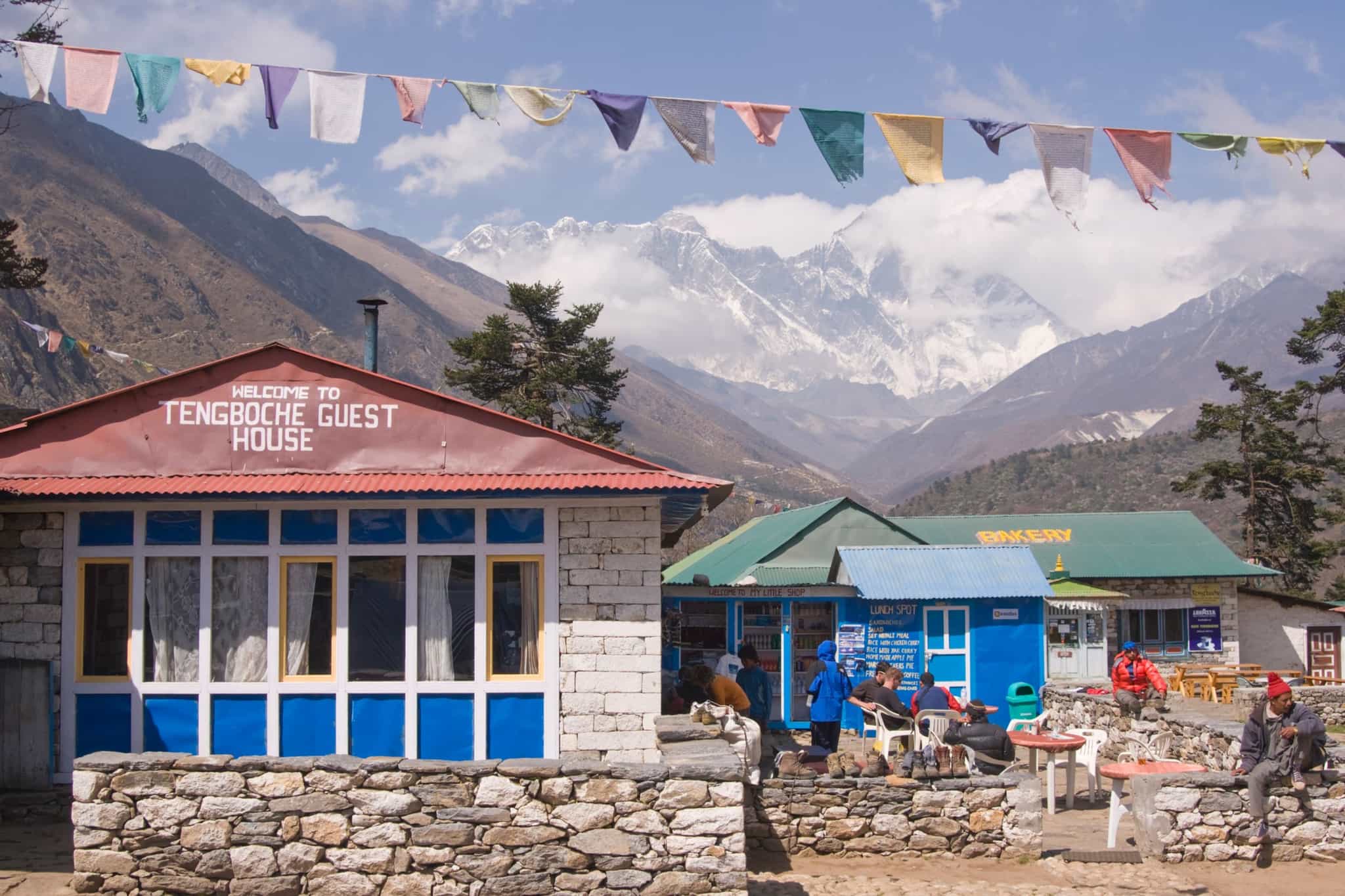
On the trek
Generally, most adventures to Nepal are in remote areas where the accommodation will be basic. On the trek you will stay in traditional Himalayan teahouses – mountain lodges that tend to have a communal dining area and basic toilets. The rooms are sorted by gender – however, if there is an odd number in the group they may occasionally be mixed. There’s no heating, so you'll need your warm sleeping bag. WiFi and hot showers are often available at a small cost. You can usually charge your cell phone up – again, you guessed it, for a cost. So remember to take an adapter.
Upgrades
For solo travellers looking for their own space, an optional private room can be booked for the two nights in Kathmandu only, subject to availability. This option is not available in the teahouses. Please request this at the time of booking: see Optional Extras below for prices.
This trip has been rated as Moderate
This trip has 4-6 hours of trekking per day, at altitudes up to 12,500 ft. There are a few steep climbs but you have plenty of time to complete each day's trek with downtime in the afternoons. It is important to note that trekking at altitudes above 9,800 ft is more demanding on the body than walking at low elevations.
This trip is a great introduction to Himalayan trekking – as a moderate-graded hike, it's designed to give you a taste of the more challenging Everest Base Camp (EBC) trek. Avoiding the higher reaches of the EBC trek, the altitudes you reach on this trek are less challenging and allow you to focus on the awesome scenery. However, you'll still see many of the same epic mountain views and cultural sites along the way.
To be ready to take on this trip, you'll want to be comfortable hiking back-to-back days in hilly terrain. Getting out on a couple of practice hikes on the weekends, walking similar daily distances and ascents (5-6 hours, 1,650-2,650 ft ascent), will help prepare your body. Some general exercise (strength, cardio, flexibility) in the weeks building up to your trip will also go a long way to ensure you're in the right shape to enjoy this trip.
What will I need to carry?
This trip includes one porter for every two trekkers. They will carry up to 45-55 lbs of gear so your overnight bags and spare clothes will be transported for you (maximum 26 lbs per person). You will only need to carry a daypack with essentials (extra layer, snacks, water, sunscreen, camera, etc.)
There are three different seasons for trekking in Nepal:
Winter (Dec-Feb): Despite being seen as ‘off-season’ this is often the best time to trek in Nepal. The nights can be very cold (down to minus 4°F), but the trails are quieter and the mountain views are often at their best due to the clear sunny skies.
Pre-Monsoon/Spring (March-May): Temperatures rise significantly in spring and flowers are in full bloom in the lower lands. Although it can still drop below freezing at night, the daytime temperatures tend to sit between 50-59°F.
Post-Monsoon/Fall (Sept-Nov): This is the most popular time to trek in Nepal with sunny and mild days generally. It can get cold and windy at higher altitudes; however, skies are usually clear.
Of course, mountain weather is notoriously hard to predict and snow can be expected on any trip – so do come prepared.

Great trek
My recent trip was truly unforgettable. The views are stunning, people are friendly and welcoming, and the amount of stuff you see in only 10 days is insane. From start to finish, everything was organised with great care, and each moment felt smooth, safe, and exciting.
A huge part of this wonderful experience was thanks to the incredible team who supported us throughout the journey. BBC, Santa Bir, Sai Kumar, Langa, and Tej were exceptional — always attentive, thoughtful, and ready to help with anything we needed. Their professionalism and friendly guidance made every step enjoyable, whether we were trekking, exploring, or simply taking in the views.
Incredible adventure
This whole trip was amazing with very scenic treks, knowledgeable guides and brilliant organisation which gave us the opportunity to trek at a good pace, experience the trekking world in the Himalayas and discover the culture of this part of Nepal. I saw and learnt so much.
Our main guide, Tejshree, was insppiring as a leader, ensuring a seamless servive with her team; always there to get things done and provide so much knowledge about the treks and local culture, as well as making us feel safe and cared for.
Our assistant guide, BBC, was very experienced and great to have around and our supporters Santa Bir, Sai Kumar and Langa, somehow managed to efficiently get our bags from one place to the next before we arrived, without us even seeing them!
A fantastic trip that I would definitely recommend for those who want to learn, trek and see amazing scenery without going too high.




Epic adventure!!
Could not have asked for better trek leader than Tej and her assistant guide BBC. They made this trip all that it truly was by being warm, welcoming, having humor with our group, and taking the time to get to know each of us. When I got sick at the end of my trip Tej personally took the time to take me to pharmacy and check up on me after my departure. Truly caring leadership and we all enjoyed our time together but especially so because of this fantastic local hosts.
Paul
I had a wonderful time led by Tej from Freedom, supported by BBC and 3 great supporters carrying our gear.





Everest Panorama Trek
My wife and I have just finished the Everest Panorama Trek organised by Much Better Adventures and I can’t recommend it highly enough. From start to finish we had the most amazing experience with our highly skilled and knowledgeable guide Ujjwal. The highlight was of course seeing the mighty Everest in all its glory but the trip was so much more than that. If you are looking for a truly authentic trek in the Himalayas look no further and book this trip and make sure you ask for Ujjwal, you will not be disappointed.

JamJam squad flying high
Truly special trip, getting better with experience. Stunning views, people, food, and overall adventure. You have to muck in at times, but it’s 100% worth it. The freedom team was excellent from start to finish. Shout out to Ujwal, our guide, 10/10 personality and knowledge to keep you safe, excited, and laughing along the way.
Panorama Trail
On the whole I had an excellent time on the Everest Panorama Trail, this was primarily influenced by the quality of the guides/porters and the stunning scenery.
Our Guides, Kevin and Ujjwal, were excellent, very knowledgeable and personable. Kevin made a particular effort to monitor the health and happiness of all members of the group and dealt admirably with some difficult members. I have been on a couple of similar trekking trips and would say Kevin has been by far the best guide I have ever had, he was extremely professional throughout and I really had the feeling of walking with a friend. Ujjwal did an excellent job of keeping morale high in the team and doubled up as a porter where necessary to ensure that people on the trip got down safely. On one of the days I walked with our porters due to the split in the group and they did an excellent job of ensuring we took breaks when necessary and stopped at the most scenic views, they also did a good job at pointing out specific landmarks etc.
There were aspects of the tour which I would say were poorly organised, particularly the rapid increase in altitude. I would recommend spending an additional night in Namche. As this trek is advertised as "moderate" difficulty and in my opinion the hardest part of these treks is dealing with altitude gain therefore it should be no more extreme than other Everest treks. Additionally, as the trek is advertised as "moderate" you should expect less fit participants, therefore I would suggest that you assign a higher number of guides as our group split due to both fitness and health issues, whilst our porters were great and one of them is in training to be an assistant guide this should not be relied upon.
Itinerary Activities
- 6 days of guided trekking in the Khumbu Valley, between Lukla and Tengboche
Guides
- Expert, English-speaking Sherpa guides
Lodging
- 2 nights in a 3-star hotel in Kathmandu
- 1 night glamping in a safari tent in Manthali
- 7 nights in teahouses on the trek
Food
- 2 tasty hotel breakfasts
- 2 dinners in Kathmandu
Domestic Flights
- Round-trip domestic flights between Manthali and Lukla
Transfers
- Arrival transfer from Kathmandu Airport at any time on Day 1
- Departure transfer to Kathmandu Airport at any time on Day 11
- All transfers during the trip
Porter Service
- Team of porters to carry all your equipment
Permits
- All trekking permits and national park entrances
Our trips are hassle-free by design. We include all the activities and equipment, so you can simply rock up with your rucksack and share the adventure with your new pals.
Travel to and from the trip
Our trips do not include flights, trains or other travel to the start point and back from the end point.
Meals
We do not include meals on the trekking part of this trip, as from experience we know that altitude and physical exercise can mean appetites vary hugely. The cost of food rises as you ascend as it is all carried in by porters and yaks and as you get higher up, very little food can be grown. How much you spend per day will vary according to your choice of meal but generally, people spend between $35-$45 per person, per day on meals and hot drinks. Below is an approximate breakdown of some items:
- Dal baht: $4 to $7
- Chow mein: $2 to $4
- Eggs: $2 to $4
- Toast: $1.50 to $3
- Tea/hot chocolate: $1 to $3
- Chocolate bars: $2 to $4
Teahouses will provide cold water free of charge; however, it needs to be treated to enable you to drink it. Please read the FAQ below regarding our advice here.
Miscellaneous Costs
Other extra costs at the teahouses to be considered are:
- Shower: $2-$4
- WiFi: $2-5
- Electricity: $2-5
See the below FAQ 'What’s Plan B in case of Lukla flight cancellations?' also.
Tips
It is customary in Nepal to tip guides and porters. Although it may not be customary to you, it is of considerable significance to the people who will take care of you during your travels. You can give any tips to your lead guide at the end of your trip. This will then be shared amongst the whole team. For full transparency, the lead guide will distribute the tips to the guides and porters in your presence. It is customary for the guides to receive a higher share than the porters as they are more highly qualified.
A good rule of thumb is around $80-100pp as a tip, although the amount you give is entirely your choice.
If you would like to give an additional tip to a member of the team who has supported you personally, please do so directly and discretely.
Personal expenses
You know your own spending habits best, so please budget an appropriate amount for things like drinks, shopping, optional activities and laundry.
Travel insurance
Travel insurance is compulsory for all of our adventures, and you'll need to provide your policy details before departure. Your insurance should offer adequate cover for overseas medical treatment, evacuation/repatriation, your baggage and equipment, and the specific activities involved in your adventure. We also recommend ensuring your policy includes cancellation and curtailment cover, in case you're unable to join your trip due to unforeseen circumstances such as illness.
Standard travel insurance may not cover all the activities included in your adventure, so it's essential to check the details carefully. There are adventure-specific providers that many travelers have used in the past, such as True Traveller (for those based in the UK or Europe), or Rise + Shield, both of which offer cover for a wide range of adventurous activities.
Please make sure your chosen policy meets your individual needs and covers all aspects of your trip.
Visas
Visa requirements often change, and you are responsible for obtaining any required visas for this trip. Please check with your nearest embassy or consulate for up-to-date advice.
What do I need to bring?
BAGS
- Day pack with rain cover (30 liters +)
- Backpack or duffel bag (for the porters to carry overnight gear)
CLOTHES
- Waterproof jacket
- Lightweight down jacket
- Waterproof pants
- Lightweight trekking pants
- Hiking shorts (if trekking in the summer)
- Thermals (top and bottom, merino ideal)
- 2-3 trekking t-shirts/shirts
- Fleece or warm mid-layer
- Waterproof thick gloves
- Glove liners
- Hiking socks and lighter walking socks
- Wool hat
- Sun hat
- Spare underwear
- Buff or similar
SHOES
- Worn in waterproof hiking boots
- Lightweight sneakers (for the evenings)
SLEEPING
- 3-4 season sleeping bag
- Sleeping bag liner
- Pillow case (optional)
OTHER
- Trekking poles
- Travel towel
- Sun protection (sunscreen, sunglasses)
- 2 water bottles (1 liter each)
- Metal SIGG bottle (useful to fill with hot water to use as a hot water bottle at bedtime)
- Flashlight
- first-aid kit and/or personal medication
- Water purification tablets/system
- Biodegradable wet wipes
- Hand gel
- Small biodegradable bags to take toilet tissue off the mountain
- Toilet paper/tissues
- Powerbank
- Universal plug adapter
- Book/kindle/cards for downtime
What's available to rent?
The below can be rented in Kathmandu:
Down jacket: approximately $1.50 per day, with a deposit of $50
Sleeping bag (only 3-season are available): approximately $2 per day, with a deposit of $80
(Please ask your host if this is needed so they can assist you with how to arrange the rent)
WHAT CAN YOU BUY IN KATHMANDU?
Kathmandu has many outdoor gear shops - some are real with gear that is the same price you will find it at home and some are filled with cheaper imitation gear that may not be of the same quality. You will however find a soft duffel bag easily that the porters can carry.
WEIGHT RESTRICTIONS
There is a weight restriction on the flight to and from Lukla of 22 lbs checked baggage plus 11 lbs hand luggage. It is not a problem for you to check in 2-4 lbs more than this as long as you are happy to pay an excess luggage charge (approx. £0.45 per lb). Some items may be left in the hotel in Kathmandu if necessary.
Please remove all unnecessary packing before you leave home and ensure you take all plastic off the mountain to be disposed of in Kathmandu.
Pre/post-trip accommodation in Kathmandu (Single)
Payable Before Departure
Pre/post-trip accommodation in Kathmandu (Single)
…
Pre/post-trip accommodation in Kathmandu (Twin/Double)
Payable Before Departure
Pre/post-trip accommodation in Kathmandu (Twin/Double)
…
Optional Private Room Upgrade (2 nights, Kathmandu only)
Payable Before Departure
Optional Private Room Upgrade (2 nights, Kathmandu only)
… Per person
We partner with the World Land Trust to ensure this trip achieves Net-Zero emissions. We also support their Buy an Acre program, helping local communities to buy and protect natural habitats in perpetuity.
What's the number?
It works out on average at 156kg of CO2 emissions per person, including all local transport, accommodation, food, activities, guides, staff and office operations.
The only thing it doesn’t include right now is flights and travel to the destination. We do make an overall estimate across all our customers separately, but as we don’t book flights, have customers from all corners of the world, and no way of reliably knowing their travel plans, we simply can’t include an individual number in the figure on display here. We’ve got a goal to fix that, so that when you book, there is a way to measure and mitigate the carbon emitted by your flight too.
But what does the number mean?
Yep, hard to picture eh? To give you an idea:
- Driving 1000 miles/1609km would be approximately 281kg of CO2 in an average car (or 140.5kg per person, if there were two of you in it).
- A return economy class flight between London and New York would be approximately 1619kg (1.66 tonnes) per person.
- 10 trees in a temperate forest are estimated to remove approximately 250kg of CO2 from the air in a period of 5-10 years.
What are we doing about it?
Our trips are relatively low-carbon by design, and we're working with all our hosts to develop long term carbon reduction plans. We partner with the World Land Trust to ensure this trip achieves Net-Zero emissions. We also support their Buy an Acre programme, helping local communities to buy and protect natural habitats in perpetuity, ensuring the protection of the reserve and its wildlife.
Want to know more?
Amazingly, no international travel company has ever publicly published their carbon measurements before, as far as we know. We believe that must change, quickly. So we’re openly sharing the method we used in the hope that other companies will be able to more easily follow suit and build on what we've done so far. You'll find it all here.
You will have one trek leader who will accompany you from the start to the end of the trip. From Lukla, you will also be accompanied by one porter for every two trekkers.
A mountain flight to Lukla is included on Day 3 of this trip, and back from Lukla on Day 10. Although we schedule departure dates outside of the main monsoon season, weather conditions in any mountain region can be unpredictable. It is not uncommon for flights to and from Lukla to be delayed or canceled during the trekking season. If your flight to Lukla is canceled, then your host will revert to 'Plan B', as follows:
You will spend an extra night in Manthali and attempt to fly the next day. If you reach Lukla on Day 4, you'll skip the acclimatization day in Namche, but the rest of your itinerary will remain the same.
If flights to Lukla are still not operating on Day 4, there may be the option to charter helicopters for the group (subject to availability). Helicopters are less hindered by poor conditions and can often fly when planes cannot. Anyone taking this option will need to pay roughly $500 (USD) extra per person (the full helicopter cost is more than this, but your canceled Lukla flight will be refunded and deducted from the total price). The exact cost will vary depending on group size, number of helicopters needed, and demand on the given day.
If there are more than two consecutive days of Lukla flight cancellations and it has not been possible to reach Lukla/Kharikhola by the alternative means described above on or before Day 4, your host will offer an alternative itinerary or trek in a different region.
See also 'When should I book my return flight?'
The flight from Lukla to Kathmandu at the end of the trip is usually reliable; however, if the weather is poor, cancelations can happen, and there is a chance that you will have to fly the next day. To play it safe, we advise you to consider reserving an extra night's accommodation in Kathmandu at the end of the trip.
Excess luggage can be left in your hotel in Kathmandu.
Although most teahouses have the option to buy bottled water, we advise against it to reduce the use of plastic in the mountains (this ends up being burned or in landfill out of sight). You will instead be provided with cold water that needs treating. There is a wide range of products available these days which are more effective than traditional purification tablets - some trekkers like to use UV handheld devices such as a Steripen but other options are available (just check the performance in freezing conditions).
There is a weight restriction on the flight to and from Lukla of 22 lbs checked baggage plus 11 lbs hand luggage. It is not a problem for you to check in 2-4 lbs more than this as long as you are happy to pay an excess luggage charge (approx. £0.45 per lb). Some items may be left in the hotel in Kathmandu if necessary.
This trip includes one porter for every two trekkers. They will carry up to 44-55 lbs of gear so your overnight bags and spare clothes will be transported for you (maximum 26 lbs per person). You will only need to carry a ‘day pack’ with essentials in (extra layer, snacks, water, sunscreen, camera etc.
The preferred currency is the Nepalese Rupee (NPR). While ATMs are available in the main cities, please do not rely on them as they are often out of order and most have a maximum withdrawal limit equivalent to about $365.
It's best to bring the bulk of your money with you in cash and exchange it at a bank or at one of the many money changers in Nepal - your guide will help you with this. Most major currencies are accepted, including British Pounds (Sterling), Euros, and US Dollars, however Scottish or Northern Irish currency cannot be changed. Keep your exchange receipts in case you want to change any unused Rupees back into hard currency when you leave Nepal (it is illegal to export Nepalese Rupees as it is a closed currency).
You will need to carry a fairly large amount of cash while trekking for the meals. We advise that you keep this in a waterproof bag and in your day bag along with your passport.
We work with some of the best leaders in the industry. Every single one of them is government licensed and very experienced. To ensure the guides' high standard of performance, the host provides them with top-notch in-house training that covers Leave No Trace (LNT) principles, advanced wilderness first aid, hyperbaric chambers, oxygen systems, mountain rescue, and incident management.
This trip includes a round-trip domestic flight to Lukla. Nepal's mountainous terrain and weather create challenging flying conditions, and unfortunately, more incidents (including fatalities) occur here than in other countries. Since 2013, the EU has banned all Nepalese domestic airlines from flying within EU airspace to raise awareness of the poor safety record (although no Nepalese airlines were operating routes within the EU prior to the ban). You should be aware that flying in Nepal is an identified risk: please consider this carefully before making a reservation. Additional info can be found on the Aviation Safety Network entry for Nepal as well as the U.S Department of State travel advice for Nepal. Domestic airlines in Nepal are generally not accredited by any internationally recognized safety audit systems, and the Civil Aviation Authority of Nepal does not operate to the same standards as those of Western nations.
What does Much Better Adventures do about this?
Much Better Adventures collaborates with other UK travel companies that arrange for independent air-safety auditors to visit Nepal annually to assess the local airlines. Much Better Adventures then only uses the carriers that were approved as part of the most recent audit. If any concerns are subsequently raised about an approved airline between audits, we put them on hold until the auditors are satisfied that safety standards are being met.
We've sourced some great optional activities for you to do in and around Kathmandu should you wish to explore the area further. Please discuss these directly with your host, who will be able to reserve them for you.
Cook Like a Local: This short cooking workshop (approximately 3 hours) teaches you how to cook popular Nepali dishes like momos and dal bhat. You'll meet your teacher and accompany them shopping, then head to the kitchen and learn to cook alongside them. Price: pay what you think the workshop is worth!
Shop Local: A 2-3 hour guided exploration of the markets of Kathmandu. Learn about the vendors that line the narrow and crowded alleyways and witness everything you could ever imagine being sold, haggled, or bargained for. It’s a great chance to learn about the melting pot of cultures that exist in Kathmandu. Price: $9-$50 per person, depending on group size.
Master of the Arts: Patan Durbar Square is popular for its handicrafts, and this trip will explore the local factories where they are produced. You’ll visit 2-3 factories and learn about the traditional processes they use and see artwork being produced. Price: $14-$59 per person, depending on group size.
Introduction to Shamanism: Shamanism, which is believed to heal many diseases, is not practiced widely these days. However, this trip enables you to meet a practicing Guru and learn all about this age-old tradition. You’ll visit a small house for an introduction, followed by lunch and then a drumming session where you’ll learn the importance of rhythm to healing. Price: $90-$150 per person, depending on group size.
This trip visits locations at or above 8,200ft, where some people may experience symptoms of Altitude Sickness, also known as Acute Mountain Sickness (AMS).
Previous experience at altitude doesn’t guarantee the same response again – your body can react differently on each trip. However, having been at altitude before is still valuable: it gives you a better understanding of how your body might respond, what symptoms to look out for, and how to manage your pace and energy levels.
Your guide is trained to manage the risk of altitude sickness by controlling the rate of ascent, monitoring group well-being, and responding appropriately if anyone feels unwell.
Before booking, we recommend considering your personal health, particularly if you have any pre-existing conditions, and consulting a medical professional if you’re unsure. Arriving early to allow your body to acclimatize can also make a big difference.
Your travel insurance must cover the maximum altitude reached on this trip and include emergency evacuation.
Sure can! Over 70% of our travellers travel solo, it’s a great way to meet like-minded people.
Our team of Adventure Hunters co-create exclusive adventures which are run by highly vetted, specialist hosts. The trip is run by our trusted host partner in the destination. We only work with independent, local, in-destination experts who know the very best places to explore and how to stay safe. Read more information about the local teams we partner with. You’ll be introduced to the host straight after making a booking via the Much Better Adventures platform.
Much Better Adventures refer to the UK Government’s official travel advice when designing trips and monitoring trip operations. We recommend that all customers review the practical information available on the UK Government’s FCDO website, where you can find up-to-date advice by searching for your destination(s).
If you are based in the United States, you can also check the latest travel advisories from the U.S. Department of State.
For customers joining from other international locations, we recommend checking the official travel advice issued by your country of residence, as guidance may vary.
We recommend checking out the country-specific information and also talking to a travel nurse.
We automatically convert prices from the local currency that a host receives to your chosen currency. We update our exchange rates daily, so prices displayed on the site are subject to currency fluctuations, which is why you may see them change over time.
If you wish to change the currency you pay in, head to the bottom of the page.
All of our group adventures are specially designed for adults to enjoy as we want these adventures to bring together outdoorsy people who are truly like-minded. You must be over 18 to join one of our trips.
You're always in good company on one of our adventures.
Our trips typically consist of a mix of solo travelers and small groups of 2 or 3 friends, with most in their 30s-50s.
Our sociable adventures are solo-friendly by design and naturally attract outdoorsy people with a shared mindset; a love for adventure, a desire to push themselves, and meet awesome, like-minded people along the way.
It’s this camaraderie that has so often turned a great adventure into a life-changing one.
Don't just take our word for it:
- 95% of people rate the group dynamics on our trips 5/5
- 90% of people recommend joining a trip to make new friends
- 75% of people have met people on our trips that they would now consider friends
See here for more info about the Much Better Adventures tribe.
Reviews

Great trek
Kate Z. November 2025

Epic adventure!!
Christopher L. November 2025

Everest Panorama Trek
Llorett K. October 2025

JamJam squad flying high
Adam H. October 2025
Incredible adventure
Janette T. November 2025
"This whole trip was amazing with very scenic treks, knowledgeable guides and brilliant organisation which gave us the opportunity to trek at a good pace, experience the trekking world in the Himalayas and discover the culture of this part of Nepal. I saw and learnt so much. Our main guide, Tejshree, was insppiring as a leader, ensuring a seamless servive with her team; always there to get things done and provide so much knowledge about the treks and local culture, as well as making us feel safe and cared for. Our assistant guide, BBC, was very experienced and great to have around and our supporters Santa Bir, Sai Kumar and Langa, somehow managed to efficiently get our bags from one place to the next before we arrived, without us even seeing them! A fantastic trip that I would definitely recommend for those who want to learn, trek and see amazing scenery without going too high."
Paul
Paul S. November 2025
"I had a wonderful time led by Tej from Freedom, supported by BBC and 3 great supporters carrying our gear."
Panorama Trail
Cameron T. May 2025
"On the whole I had an excellent time on the Everest Panorama Trail, this was primarily influenced by the quality of the guides/porters and the stunning scenery. Our Guides, Kevin and Ujjwal, were excellent, very knowledgeable and personable. Kevin made a particular effort to monitor the health and happiness of all members of the group and dealt admirably with some difficult members. I have been on a couple of similar trekking trips and would say Kevin has been by far the best guide I have ever had, he was extremely professional throughout and I really had the feeling of walking with a friend. Ujjwal did an excellent job of keeping morale high in the team and doubled up as a porter where necessary to ensure that people on the trip got down safely. On one of the days I walked with our porters due to the split in the group and they did an excellent job of ensuring we took breaks when necessary and stopped at the most scenic views, they also did a good job at pointing out specific landmarks etc. There were aspects of the tour which I would say were poorly organised, particularly the rapid increase in altitude. I would recommend spending an additional night in Namche. As this trek is advertised as "moderate" difficulty and in my opinion the hardest part of these treks is dealing with altitude gain therefore it should be no more extreme than other Everest treks. Additionally, as the trek is advertised as "moderate" you should expect less fit participants, therefore I would suggest that you assign a higher number of guides as our group split due to both fitness and health issues, whilst our porters were great and one of them is in training to be an assistant guide this should not be relied upon."
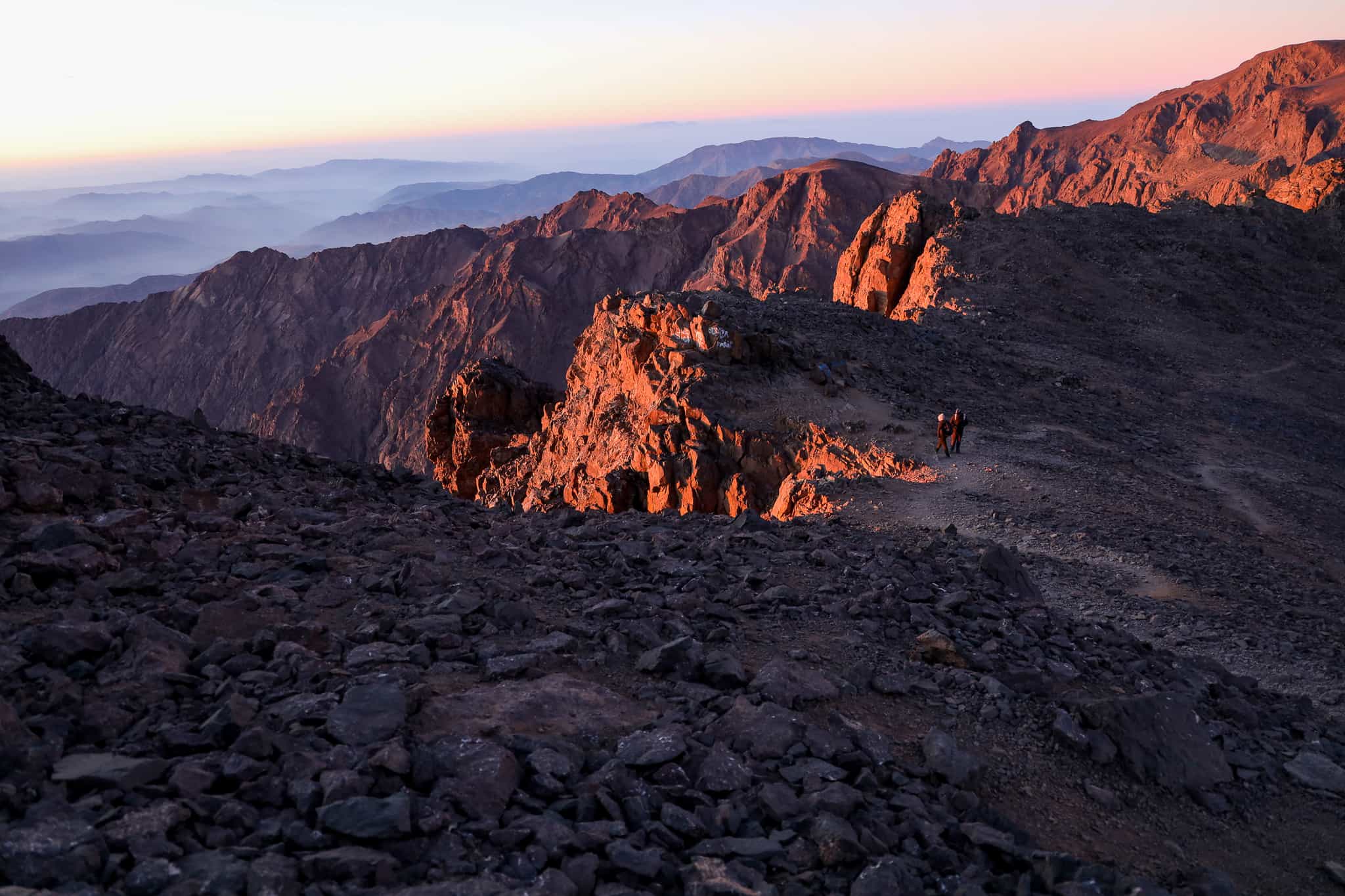
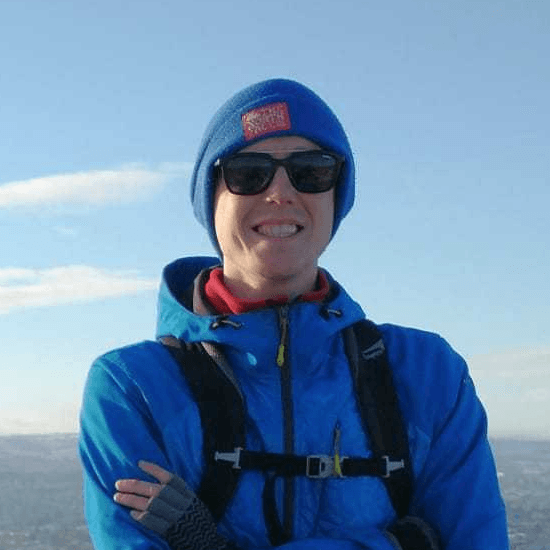
Need help finding flights?
From logistics and how to get there, to fitness, group dynamic and trip difficulty, Rory and his team of friendly experts are on hand to help.
We've got your back
Guaranteed to run
All Much Better Adventures trips are guaranteed to run. Once you’ve booked your spot you can immediately make your travel arrangements, no uncertainty, no hanging about (excludes 'request to book' departures). Full details
Flexible payments
Secure your spot with the minimum deposit and pay off the remaining balance in as many installments as you like, with no interest or fees. Full details
Happiness Guarantee
We’re so confident you’ll have an amazing time we’ll put our money on it. Full details
Full financial protection
For total peace of mind, Much Better Adventures is backed by ABTOT and ASTA memberships. Full details
Tried & Trusted
Much Better Adventures is consistently rated ‘Excellent’ on Trustpilot, with over 1000 verified trip reviews.
Connect before you go
You'll be invited to join a WhatsApp group to get to know each other before your big adventure together. Full details
DEPARTURE DATES
Friday 24th April 2026
to Monday 4th May 2026




